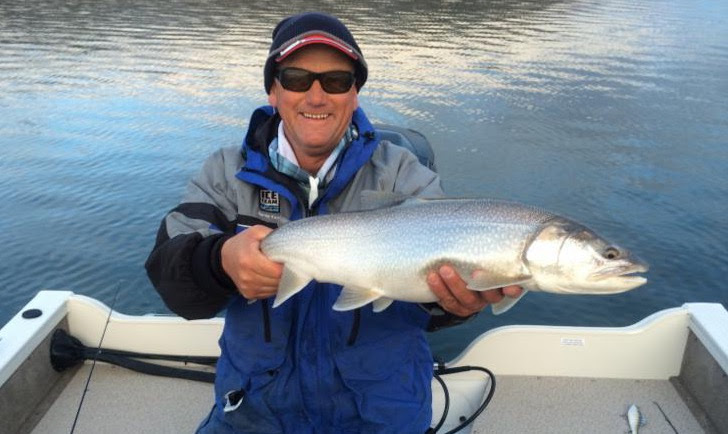Spawn to Ice: Life of a Lake Trout
Category: News Release
Nov 21st, 2016 by OutdoorsFIRST
Modified Nov 21st, 2016 at 12:00 AM
|
|
From Spawn To Ice: A Laker’s Life
|
|
Lake trout anglers are anxiously awaiting the start of the ice fishing season. But veteran guide Bernie Keefe says there’s still time to enjoy one last blast of open-water action before winter closes in.
“Many anglers know lake trout spawn in the fall, and where legal, they take advantage of the fishing opportunities it provides,” he begins. “And just as many folks know where to find the fish during that magical first-ice period.
“But there’s a gap in between the spawn and early ice periods, where few fishermen crack the locational code,” he continues. “As a result, they miss out on some fine late-fall lake trout fishing.”
Keefe, of Granby, Colorado, keeps tabs on postspawn trout. Years of on-the-water research have shown him where lakers go and how they behave after bedtime.
“When water temperatures reach 56 to 58 degrees, lake trout start heading for spawning grounds such as rocky reefs, rock ledges and other snaggy main-lake areas offering rocks soft-ball size or larger,” he says. “The spawning ritual occurs as temps drop through the 50s down to the high 40s.”
Keefe targets eater-size lakers throughout the spawn, leaving larger spawners to capitalize on their annual chance for romance. His tactics include jigging Fergie Spoons and small minnow- and twister-tail softbaits such as those in Berkley’s PowerBait and Gulp! lineups.
“At peak spawning, your catch is dominated by lakers,” he says. “But when you get a few rainbow trout down near bottom, you know it’s winding down. And when suckers show up, it’s over. These species love to eat lake trout eggs, but won’t run the gauntlet of teeth when a reef is swarming with lakers. They wait for some of the lake trout to leave before moving in.”
Keefe doesn’t abandon the honeymoon suite immediately, however. “Some lake trout remain to feed on the incoming buffet line of rainbows and suckers,” he says. “Switching to larger lures such as big tubes and hair jigs often prolongs the action in these areas.”
When that bite fizzles, Keefe looks for lakers transitioning toward their wintering spots. “The first place I look is mud,” he says. “Postspawn trout are tired and beat up. They want to lie someplace soft and relax. But they’ll still feed.”
In water temperatures below 50 degrees, lakers may be virtually anywhere from extremely shallow water out to the abyss. “They could be in three feet, 100 feet or anywhere in between,” says Keefe.
To speed his search process, he starts with muddy bottoms near the first major structural change adjacent to the spawning area. “It’s not rocket science,” he promises. “It could be a point, hump or shallow bench with mud next to it.”
In depths less than 10 feet, Keefe casts hard-bodied swimbaits such as Sebile’s 7-inch Magic Swimmer, in shades of rainbow, black, silver and bluegill. “Cast out, let the bait hit the mud, then make a varied retrieve,” he says. “Not in terms of stops and starts, but in speed changes from slow to fast and back again. You can use the rodtip, but I prefer the precise speed control of the reel handle.”
If the shallows are a bust, Keefe uses his Lowrance HDS sonar-chartplotter to scan deeper structure. “I drive around until fish are marked, then drop tubes up to 7 inches in length, or big hair jigs,” he says. “Slower jig strokes are the rule, but you can also try reeling hair jigs to the surface. Sometimes lake trout will storm up and crush them on the rise.”
Keefe notes that once you find trout in a particular area, other similar spots may produce fish as well. “Look at your lake map for areas offering the same features,” he says. “Chances are good they’ll hold transitional trout, too.”
Eventually, most migratory lakers land on classic first-ice hotspots such as humps, ridges, saddles, flats and points. But that’s a story for another day. For now, put Keefe’s postspawn strategies into play to catch late-fall trout other anglers miss.
|

